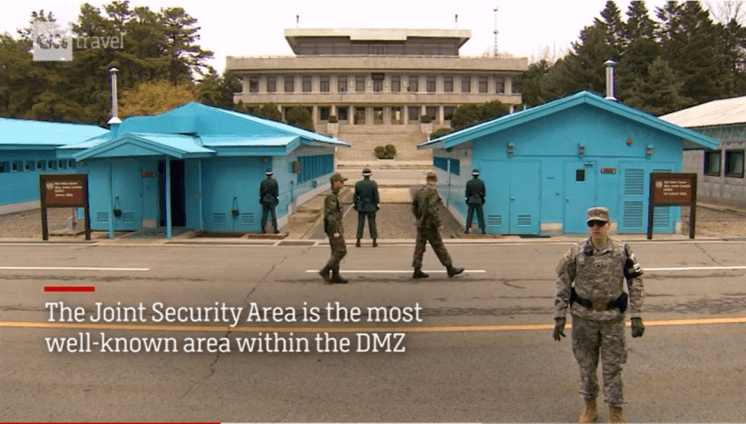Art has always had the power to be dangerous. But a newly opened art museum is taking that to another level.
It's Unimaru's location that makes it unsafe. The museum rests on the DMZ, or Korean Demilitarized Zone, a no-man's-land along the 38th parallel which divides North and South Korea.
Its inaugural exhibition, titled "2021 DMZ Art and Peace Platform," featured 34 artworks by 32 artists and opened in September 2021.

Prior to becoming a museum, Unimaru was a customs clearinghouse, where visitors went through security screening before being allowed to visit the DMZ from 2003 to 2007. This was then replaced by a bigger office.
The building sat empty until early 2021, when architecture firm MPART -- who also designed the National Museum of Modern Contemporary Art (MMCA) in Seoul -- reimagined it as Unimaru. The museum's name is a portmanteau of two Korean words: "uni," meaning one, and "maru," meaning space.
Its roof was opened up so that visitors could see more of the view and a steel facade "which represents the liminality of time and space at the DMZ," according to a statement from the museum.
Due to both security and coronavirus concerns, visitor numbers are intentionally kept small.
A maximum of five tour groups per day, with no more than 30 people per group, were allowed when the museum was open. Now Unimaru is on hiatus as it mounts its next exhibit.
People who want to visit must apply to the South Korea Ministry of Unification (MOU) -- the official government body that promotes reunification of the Koreas and dialogue between the two countries -- for permission.
Once approved, they are secured a free ticket to Unimaru and can board one of the special buses allowed to ferry civilian guests to the DMZ.

After having their IDs checked, guests are escorted around the museum by docents and staffers from the MOU. These MOU staffers are civilians and do not carry weapons.
All visitors to the DMZ must abide by a dress code that bans miniskirts, shorts, and anything with camouflage print.
They are not allowed to wave at anyone they might see or take pictures of anything without permission, just in case they run afoul of security issues.Kids under 8 years old are also barred from the DMZ, regardless of their country of origin.
In 2018, South Korean President Moon Jae-in and North Korea's chairman Kim Jong Un held an Inter-Korean Summit Meeting at the "Peace House" at Panmunjom on the DMZ.
Technically, the two nations are still at war, but at the meeting, Moon and Kim agreed to move toward formally ending their conflict. The agreement also stated that both countries would remove weapons, guards, and landmines from Joint Security Area (JSA).
It was the departure of guards from some of the military watchpoints that allowed Unimaru to display artwork on a repurposed former guard tower just a mile from the border.
Yeon Shim Chung, UniMaru's artistic director, told Artnet that she or other museum staff members wear bulletproof vests as a precaution when they go to install pieces there.

Artwork from both South Korean and international artists is on display at Unimaru.
However, one of the most striking installations is an empty frame that represents where the museum hopes to someday display work from North Korean artists.
The JSA, or Panmunjom, is probably the best known place along the DMZ because of its recognizable bright-blue conference room, which is the most-visited attraction in the area.
Former US President Bill Clinton famously said that the DMZ was the "scariest place on earth" after a state visit there in 1993.
Panmunjom tours resumed on November 30, after being suspended in July as South Korea tightened its Covid-19 restrictions.
Latest Stories
-
Environmental protection officers receive training on how to tackle climate change
3 minutes -
CLOGSAG vows to resist partisan appointments in Civil, Local Government Service
1 hour -
Peasant Farmers Association welcomes Mahama’s move to rename Agric Ministry
1 hour -
NDC grateful to chiefs, people of Bono Region -Asiedu Nketia
1 hour -
Ban on smoking in public: FDA engages food service establishments on compliance
1 hour -
Mahama’s administration to consider opening Ghana’s Mission in Budapest
1 hour -
GEPA commits to building robust systems that empower MSMEs
1 hour -
Twifo Atti-Morkwa poultry farmers in distress due to high cost of feed
1 hour -
Central Region PURC assures residents of constant water, power supply during yuletide
1 hour -
Election victory not licence to misbehave – Police to youth
1 hour -
GPL 2024/2025: Nations thrash struggling Legon Cities
1 hour -
Electoral offences have no expiry date, accountability is inevitable – Fifi Kwetey
1 hour -
Ghanaians to enjoy reliable electricity this Christmas – ECG promises
2 hours -
Police deny reports of election-related violence in Nsawam Adoagyiri
2 hours -
‘We’re not brothers; we’ll show you where power lies’ – Dafeamekpor to Afenyo-Markin
2 hours

